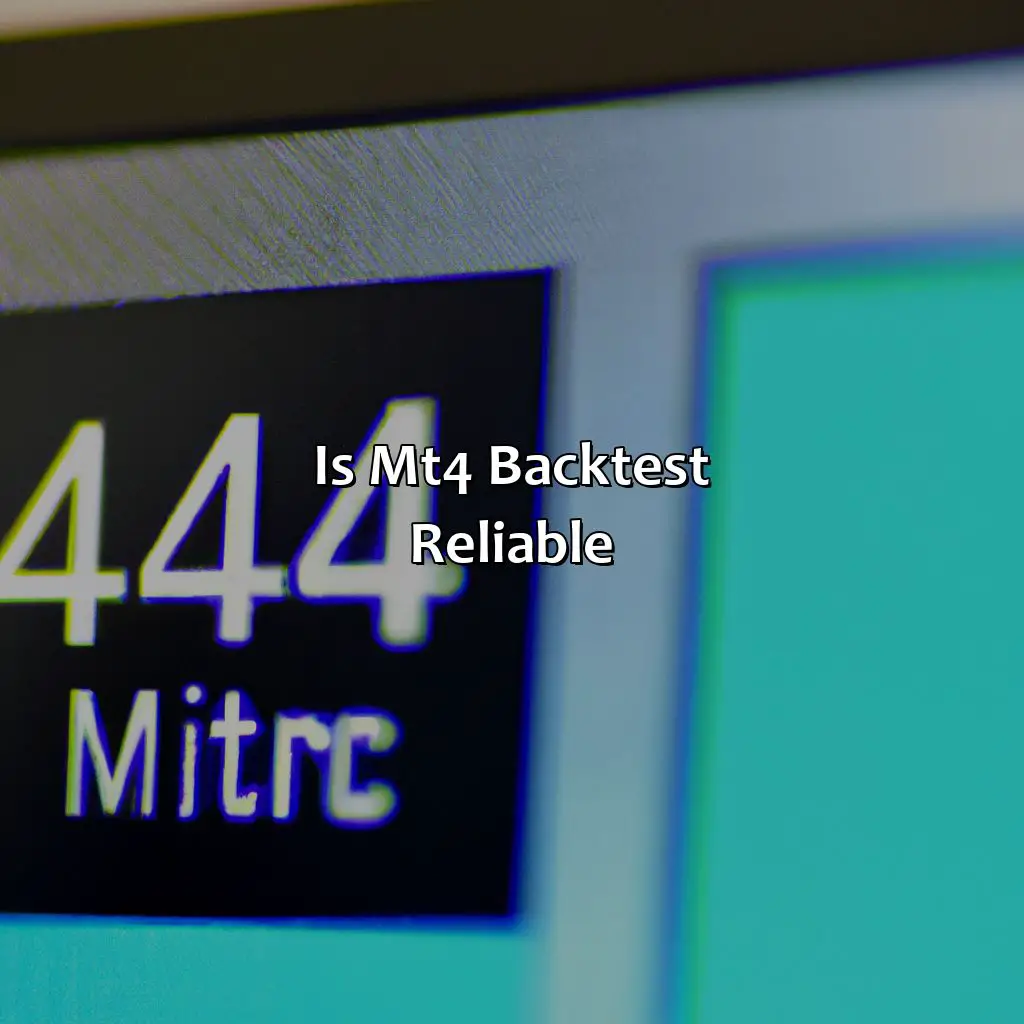
Key Takeaway:
- MT4 backtesting can be a useful tool for forex traders to test their algorithmic trading strategies using historical data. However, it should not be solely relied upon as there are limitations and factors that can affect its reliability.
- One common misconception about MT4 backtesting is that it is always accurate and reliable. This is not always true as it depends on the accuracy of the historical data, the reliability of the backtesting tools and methodology, and the trading systems and technical indicators used.
- To improve the reliability of MT4 backtesting, it is important to consider factors such as overfitting, underfitting, optimization, and market conditions. Best practices for improving reliability include evaluating and selecting appropriate historical data, reducing the impact of slippage and modeling quality, and conducting forward testing and optimization with caution.
Understanding MT4 Backtesting

Photo Credits: forexbrokerreport.com by Walter Flores
MT4 backtest is a crucial tool for forex traders to evaluate their algorithmic trading strategies. It helps to test the strategy on historical data to analyze its effectiveness before implementation.
To understand MT4 backtesting, follow these six steps:
- select the strategy
- choose the correct timeframe and instrument
- set the parameters
- optimize the strategy
- run the backtest
- and analyze the results
It is essential to note that with MT4 backtesting, the trader needs to beware of overfitting, slippage, and other discrepancies. Therefore, it’s vital to check the results on different data sets to verify its effectiveness. Lastly, to enhance the accuracy of the results, traders should consider the quality and length of historical data used in the analysis.
Common Misconceptions about MT4 Backtesting

Photo Credits: forexbrokerreport.com by Christopher Walker
Backtesting tools like MT4 are often considered unreliable due to common misconceptions. However, the accuracy and reliability of such tools depends on the testing methodology used. In order to ensure validity, it is crucial to use high-quality historical data and simulate realistic market conditions.
Furthermore, it is important to understand that backtesting results are not always indicative of future performance. There may be certain nuances in the market that cannot be replicated accurately in a backtesting environment. It is also essential to regularly assess and update testing methodologies to ensure optimal accuracy and reliability.
Incorporating MT4 backtesting into trading strategies can be highly beneficial. However, it is important to approach the process with a critical eye and constantly strive for improvement to ensure optimal results. Don’t miss out on the potential benefits of backtesting and testing tools by falling prey to common misconceptions.
Incorporate backtesting tools like MT4 into your trading strategies to improve accuracy and reliability, but remember to approach the process with a critical eye. Keep testing methodologies up-to-date and strive for continuous improvement to stay ahead of the market.
Factors Affecting the Reliability of MT4 Backtesting

Photo Credits: forexbrokerreport.com by Sean Jackson
To test your MT4 backtest reliability, you need to think of various things. To achieve accurate outcomes, you must know overfitting, underfitting, optimization and data quality.
Now, let’s look into the following subsections to ensure the quality and accuracy of your backtesting:
- Quality and Accuracy of Historical Data: This is important as inaccurate data may lead to incorrect backtesting results.
- Slippage and Modeling Quality Effects: Consider these factors as they can affect the reliability of backtesting results.
- Impact of Forward Testing and Optimization: These subsections have important words and considerations that can change your backtesting results.
Quality and Accuracy of Historical Data
Historical Data Quality and Precision
Accurate and curated historical data is vital for dependable backtesting results. The comprehensiveness, structure, timing, and resolution of the recorded price information will dictate the accuracy of the backtest. It’s essential to use an adequate amount of high-quality data covering an extended period to form a robust foundation for statistical analysis. The model’s fidelity greatly depends on its input data; therefore, one should ensure they are making realistic assumptions and not rely too heavily on short-term trends for their analysis.
Moreover, slippage and execution speed also play a significant role in determining the quality of backtesting results. Slippage happens when there’s a discrepancy between expected prices and executed trade prices due to market volatility or other factors that affect trade execution. Consequently, it is recommended that traders take into account modeling errors that stem from the limitations of simulating real market conditions during backtesting when analyzing such research findings.
When working with historical data, it’s critical to consider any minor discrepancies or informational gaps, as they can have large downstream effects on results. To achieve more reliable testing outcomes, traders should focus on identifying the most complete and relevant datasets possible by using a robust criteria selection approach that satisfies their certain needs.
Slippage and modeling quality can turn your backtesting data into science fiction, so choose wisely with your source code and backtesting settings.
Effects of Slippage and Modeling Quality
Slippage and Modeling quality can distort the accuracy of backtesting results, causing traders to develop strategies that do not work well in a live market environment. To understand the extent of their impact on backtesting, we must analyze the factors that contribute to them.
| Factors | Details |
|---|---|
| Slippage | The difference between the expected price of a trade and the actual price at which it is executed due to market volatility, liquidity, or broker latency. |
| Modeling Quality | The degree to which backtesting software replicates actual trading conditions using accurate tick data or M1 (1-minute) bar data. |
Addressing these factors’ significance in backtesting platforms is vital in creating reliable trading systems. By gathering precise historical data, broadening testing scenarios by several time frames while maintaining reasonable slippage assumptions and modeling quality assure accurate outcome-oriented reports.
As with any trading system’s development process, there are challenges associated with managing risk control and trading rules alongside emotions while remaining steadfast on good money management techniques. When entering positions following rigorous analysis of entry points by outlining suitable stop loss and take profit levels based upon position sizing guidelines and determining whether the model will have expected returns.
It is essential to keep your expectations within reason as MT4 does have limitations in terms of strategy complexity; sometimes use of proprietary source code for custom indicators prove ineffective—along with other potential constraints like forward testing accuracy beyond modeling data limitations. A single substantive approach could need accessing more proficient backtesting platforms that offer advanced capabilities or incorporate other particular parameters into strategy implementation.
When developing new trading methods through backtesting software with high-quality metrics requirements contrasted at the forefront of all decision-making strategies as trading knowledge advances over time, relying on historical or forward testing outcomes provides a convenient way to develop better trading approaches in one’s strategy development journey.
Forward testing and optimization: Where traders separate the wheat from the chaff in terms of performance metrics.
Impact of Forward Testing and Optimization
Forward testing and optimization are crucial steps in the process of MT4 backtesting. Evaluating the profitability of a trading strategy through performance metrics such as drawdown, profit factor, sharpe ratio, information ratio, calmar ratio, sortino ratio, expectancy is a must for successful trading. Trade size, frequency and duration also play critical roles.
It is essential to ensure that forward testing is performed with caution since live market conditions can be unpredictable. Optimization needs to be conducted with care since overfitting can occur if not adequately controlled. Moreover, it’s important to remember the impact of forward testing and optimizations on the reliability of MT4 backtesting results.
A tip for improved results would be ensuring that optimization is done within reasonable ranges to avoid curve-fitting. It is better to focus on building a robust strategy rather than manipulating parameters for short-term gain.
From trading costs to data cleansing, these best practices will enhance the accuracy of your MT4 backtesting.
Best Practices for Improving the Reliability of MT4 Backtesting

Photo Credits: forexbrokerreport.com by Edward Allen
Boost your MT4 backtesting trustworthiness. To do this, pick out the right historical data. Plus, reduce slippage and modeling quality effects by using care when doing forward testing and optimization. Here are the sections we’ll go into to give answers to help sharpen the correctness of your backtesting results:
Evaluating and Selecting Appropriate Historical Data
While backtesting on MT4 may seem straightforward, evaluating the historical data is just as important. Selecting appropriate data for backtesting greatly impacts the accuracy of results. One should consider factors such as data quality and accuracy, as well as timeframe, in order to minimize discrepancies between historical and live trading.
It is crucial to evaluate the source and accuracy of historical data before using them for backtesting. Reliable sources include trusted providers such as Bloomberg or Thomson Reuters. Additionally, appropriate timeframes of data usage should be considered based on the intended trading strategy.
To ensure further reliability, it is advisable to use multiple datasets during evaluation. This includes evaluating cross-checked provider sources and pooling together information found from various brokers.
It should be noted that due to the nature of financial markets, even high quality historical data may not translate perfectly when applied to live trading scenarios. Nonetheless, consistent testing over multiple periods can provide valuable insights about trends in relation to specific market conditions.
A reliable source known as ‘AuditMyFx’, enables traders to compare MT4 report results with their depth-historical analysis and verify that they are using the right set of trading tools available for optimal advantages. Smooth out your MT4 backtesting results by minimizing the impact of slippage and improving your modeling quality.
Reducing the Impact of Slippage and Modeling Quality
To improve the accuracy of MT4 backtesting results, traders must consider reducing the impact of slippage and modeling quality. Slippage occurs when there is a difference between the expected price of an order and its actual execution price. To reduce this impact, traders must ensure their historical data includes realistic bid-ask spreads and engage in high-quality backtesting with feasible assumptions on market movement.
Furthermore, modeling quality refers to how closely a strategy’s hypothetical trades match up with its historical trades. This can be improved by utilizing more precise algorithmic models that capture real-world market conditions more accurately.
To help mitigate these factors, traders should evaluate their historical data sources carefully and select high-quality providers with accurate pricing information. They should also conduct forward testing on their selected strategies to refine their modeled expectations before implementing them fully.
Interestingly, taking steps such as refining your algorithmic models and sourcing high-quality data can significantly decrease slippage impact while increasing the accuracy of your model. By constantly iterating through new data sources or improving existing methodology, you can further reduce unforeseen errors in your predictions over time.
Proceed with caution when it comes to forward testing and optimization in order to avoid the MT4 backtesting trap.
Conducting Forward Testing and Optimization with Caution
Forward testing and optimization are crucial steps in ensuring the reliability of MT4 backtesting results. It is essential to conduct these processes with great care and caution. Testing live accounts with small trade sizes can be an effective means of conducting forward testing, while avoiding risks associated with larger positions. Additionally, gradual optimization of strategies can prevent over-optimization which can lead to unrealistic testing outcomes. Through careful implementation, conducting forward testing and optimization could significantly enhance the validity of MT4 backtesting results.
To ensure accuracy, traders should focus on quality historical data when conducting forward testing and optimization with caution. The choice of parameters selected for the optimization process must be considered carefully as well since they significantly impact the test’s outcome. Furthermore, traders should model forward tests very closely with actual trading conditions to obtain a more accurate representation.
Caution must also be exercised when deploying forward-tested systems into markets. Simulated environments may operate differently from actual markets, especially during times of high volatility or low liquidity. Traders must prepare themselves for potential slippage or other market vagaries between modelled trades and real ones.
In one case study, a trader applied a strategy that performed extremely well during backtesting but failed miserably during live trading because their strategy was over-optimized for particular market conditions that were not present in actual market movements. In such cases, it’s best for traders to work with experienced professionals who have tackled similar issues for guidance.
Conducting forward testing and optimization with caution is an essential aspect of ensuring reliable results while using MT4 backtesting tools. Adopting this approach enables traders to achieve a better understanding of how their systems will perform in any given market environment. With appropriate care and attention invested in optimized system management strategies, Forex traders can gain valuable insights into which financial products offer favorable risk/reward opportunities before committing capital in pursuit of profit-making opportunities on real money trades.
MT4 backtesting isn’t perfect, but don’t worry – there are other fish in the sea.
Limitations of MT4 Backtesting and Alternative Methods

Photo Credits: forexbrokerreport.com by Donald Walker
Limitations of MT4 Backtesting: Risks and Solutions
Despite its popularity, MT4 backtesting has limitations and risks. To enhance reliability, consider alternative methods.
One limitation of MT4 backtesting is that it only simulates past conditions. Additionally, it may not consider execution speed or slippages. Advanced solutions like Tick Data Suite or third-party data providers may enhance accuracy.
Try custom indicators, or bots to automate trading strategies with different market conditions. Experts suggest stress testing through optimization or Monte Carlo simulations.
To overcome limitations of MT4 backtesting, explore alternatives like Forward testing, Walk-forward analysis, or Live trading with minimal risk. Additionally, try to verify results with demo trading or other platforms.
Evaluate multiple scenarios, consider your financial goals, understand your trading habits, pick a reliable broker, and choose a time frame suitable for your strategy. Understanding risks and solutions will complement your trading analysis.
Five Facts About MT4 Backtest Reliability:
- ✅ The MT4 backtest relies on historical data to simulate trading strategies. (Source: Investopedia)
- ✅ The reliability of MT4 backtests depends on the accuracy and completeness of historical data. (Source: Trading Heroes)
- ✅ MT4 backtests do not account for slippage, commissions, and other trading costs. (Source: Admiral Markets)
- ✅ Backtesting results should be confirmed with forward testing and real trading before implementing a strategy. (Source: My Trading Skills)
- ✅ MT4 backtests can be a useful tool for evaluating trading strategies, but should not be relied upon solely for making trading decisions. (Source: FX Empire)
FAQs about Is Mt4 Backtest Reliable?
Is MT4 backtest reliable?
MetaTrader 4 backtesting is a useful tool for traders to test their trading strategies. It can be reliable if the conditions of the backtest are set up correctly. However, traders should not solely rely on backtesting as it does not guarantee future performance.
What are some limitations of MT4 backtesting?
One of the limitations of MT4 backtesting is that it only uses historical data and does not account for current market conditions. Additionally, backtesting assumes perfect order execution and may overlook important factors such as slippage and order fills.
How can I improve the reliability of my MT4 backtesting results?
Traders can improve the reliability of their backtesting results by using high-quality historical data, incorporating real-world factors such as slippage and order fills, and testing multiple scenarios and timeframes.
Can MT4 backtesting accurately predict future performance?
No, MT4 backtesting cannot accurately predict future performance. Backtesting only evaluates past data and does not account for unpredictable market factors and changes in market conditions.
Should I solely rely on MT4 backtesting for my trading strategy?
No, traders should not solely rely on backtesting for their trading strategy. Backtesting is just one tool among many that traders can use to evaluate their strategy. Traders should also use other tools such as demo trading and forward testing to validate their strategy’s performance.
What other factors should I consider besides MT4 backtesting when evaluating my trading strategy?
Traders should also consider factors such as risk management, money management, and emotional control when evaluating their trading strategy. These factors can have a significant impact on a trader’s performance and cannot be accurately evaluated through backtesting alone.

